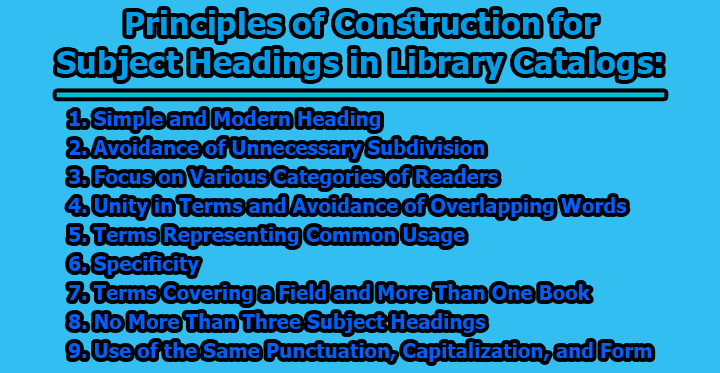Principles of Construction for Subject Headings in Library Catalogs:
Subject headings play a crucial role in organizing and providing access to the vast amount of information housed within library catalogs. These headings serve as essential tools for readers, enabling them to locate relevant materials efficiently and effectively. However, constructing subject headings requires careful consideration of various principles to ensure clarity, consistency, and usefulness. In this article, we will explore the principles of construction for subject headings in library catalogs, which are vital for creating user-friendly catalogs and bibliographies.
1. Simple and Modern Heading: The first principle of construction for subject headings is to employ simple and modern language. It is crucial to avoid using difficult, uncommon, or cumbersome phrases that might confuse or discourage readers from exploring further. By opting for straightforward and contemporary terms, libraries can make their catalogs more accessible and inviting to a broader range of users.
2. Avoidance of Unnecessary Subdivision: Subject headings should incorporate subdivisions only when they are essential and useful for organizing materials. Unnecessary subdivision can needlessly complicate the catalog and bibliography, making it harder for readers to navigate and locate relevant resources. Careful consideration should be given to whether a particular subdivision adds value or if a broader category would be more appropriate.
3. Focus on Various Categories of Readers: The construction of subject headings should take into account the diverse needs and interests of various categories and classes of readers. The goal is to select headings that will be relevant and beneficial to a wide audience. By catering to different readers’ perspectives, libraries can better serve their patrons and enhance the usability of their catalogs.
4. Unity in Terms and Avoidance of Overlapping Words: To maintain clarity and coherence in the catalog, it is essential to avoid overlapping subject headings that have similar meanings. Instead, the catalog should use representative and unambiguous terms that unite different phrases used by various writers over time. This approach ensures that users can find all relevant materials under a single, well-defined subject heading, streamlining the search process.
Example:
- Biology-574 (class no)
- Life Biology-574 (Class no)
5. Terms Representing Common Usage: Subject headings should reflect common usage and be familiar to users or at least demonstrate a clear need and potential use for a specific class of readers. This principle ensures that the headings resonate with library patrons and align with their expectations when searching for materials on a given topic.
6. Specificity: The principle of specificity guides the choice of subject headings, favoring precise and focused headings over broad ones. For instance, if the contents of a book pertain specifically to embryology-574.33, the broader heading “Biology” should be avoided. Specific headings enable users to quickly identify resources that align precisely with their research needs, resulting in a more efficient catalog browsing experience.
7. Terms Covering a Field and More Than One Book: Conversely, subject headings should be chosen to cover a particular field and be applicable to more than just one book. This principle facilitates the organization of related materials under a unified heading, ensuring that users can access all relevant resources on a given topic without encountering unnecessary redundancy.
8. No More Than Three Subject Headings: When a publication covers more than one area of interest, librarians should use a maximum of three subject headings to categorize it. This practice prevents excessive fragmentation of resources and helps users quickly grasp the main focus of the material. If the publication covers more than three distinct topics, a general heading may be employed to encompass the overarching theme.
9. Use of the Same Punctuation, Capitalization, and Form: To maintain uniformity and consistency, it is crucial to employ the same punctuation, spelling, capitalization, and form for subject headings throughout the catalog. This principle ensures that users can predict the structure of subject headings and easily navigate the catalog without encountering unexpected variations in formatting.
In conclusion, the construction of subject headings is a meticulous process that demands adherence to several fundamental principles. By employing simple and modern language, avoiding unnecessary subdivisions, focusing on diverse categories of readers, and maintaining unity in terms, libraries can create user-friendly catalogs that cater to patrons’ needs effectively. Specificity in subject headings and the use of terms covering a field and more than one book further enhance the organization of resources, making them easily accessible to library users. By limiting the number of subject headings per publication and adhering to consistent punctuation, capitalization, and form, libraries can ensure a cohesive and well-organized catalog experience for all patrons. Implementing these principles will undoubtedly contribute to the improvement of library services and the satisfaction of readers in their quest for knowledge.
Frequently Asked Questions [FAQs]:
What are subject headings, and why are they important?
Subject headings are standardized terms used to describe the content of books, articles, and other materials in library catalogs. They serve as essential tools for organizing and categorizing resources, allowing users to find relevant materials efficiently. Subject headings help users discover materials on specific topics, streamline searches, and enable librarians to create coherent and user-friendly catalogs.
How are subject headings constructed?
Subject headings are constructed based on established principles. Some key principles include using simple and modern language, avoiding unnecessary subdivisions, focusing on diverse categories of readers, and ensuring specificity in the chosen headings. Additionally, subject headings should represent common usage and use the same punctuation, capitalization, and form to maintain consistency.
Why should unnecessary subdivisions be avoided?
Unnecessary subdivisions complicate the catalog and may confuse users while searching for materials. By using subdivisions only when essential and useful, the catalog becomes more accessible and user-friendly. It ensures that the organization of resources is clear and concise, making it easier for users to locate the information they need.
How do subject headings benefit library users?
Subject headings offer several benefits to library users. They provide a structured and systematic way to browse materials on specific topics. By using subject headings, users can easily find related resources without the need for exhaustive keyword searches. Additionally, subject headings enhance information retrieval, saving users time and effort in their research endeavors.
Can the same book have multiple subject headings?
Yes, a single book can have multiple subject headings if it covers multiple topics or addresses different aspects. However, librarians usually limit the number of subject headings to a maximum of three per publication to maintain focus and avoid excessive fragmentation of resources.
How are subject headings chosen?
Librarians and catalogers select subject headings based on established rules and guidelines. They consider the content of the material, the primary focus of the work, and the needs of various categories of readers. The goal is to choose subject headings that accurately represent the content while ensuring ease of access for library users.
What is the importance of specificity in subject headings?
Specificity in subject headings ensures that users can quickly identify resources that precisely match their information needs. By using specific headings, librarians can create targeted categories for specialized topics, allowing users to find resources directly related to their research interests.
Why is consistency in punctuation and capitalization necessary for subject headings?
Consistency in punctuation and capitalization is essential to maintain uniformity throughout the catalog. It helps users recognize subject headings quickly and ensures a smooth and predictable browsing experience. Consistent formatting also aids in accurate and efficient information retrieval.

Former Student at Rajshahi University










